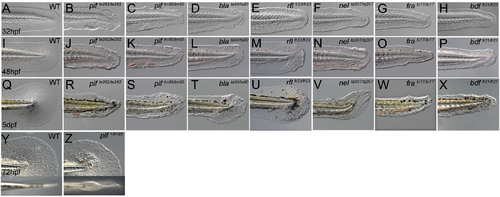Fig. S1
- ID
- ZDB-FIG-100504-32
- Publication
- Carney et al., 2010 - Genetic analysis of fin development in zebrafish identifies furin and hemicentin1 as potential novel Fraser Syndrome disease genes
- Other Figures
- All Figure Page
- Back to All Figure Page
|
Zebrafish fin mutants can be classed in two phenotypic groups. (A–X) Lateral Normarski images of the mutants pinfin (B–C, J–K, R–S), blasenta90 (D, L, T), rafelsfr23 (E,M,U), nageltq207 (F, N, V), fransentc17 (G, O, W) and badfinfr21 (H, P, X) displaying medial fin defects compared to wild-type embryos (A,I,Q). Embryos are shown at 32 hpf (A–H), 48 hpf (I–P) and 5 dpf (Q–X). Images of both a strong (pifte262; B, J, R) and a weak (piftm95; C, K, S) allele of pinfin are shown, which along with blasen, rafels and nagel, all display blisters within the fin fold. In contrast fransen and badfin mutants do not show blisters, rather dysmorphogenesis from 32 hpf onwards. Within the group of blister mutants, there was a range of severity, such that the blisters of the weak pinfin allele (piftm95) and the single blasen allele (blata90) appear quite small at 30 hpf and are only visible in some mutant embryos at 48 hpf, whilst the blisters of the strongest pinfin allele (pifte262) are prominent at 30 hpf and always visible at 48 hpf. The blisters of the rafels alleles are clear but only prominent in the posterior medial fin at 48 hpf and not evident at 32 hpf. The extent of fin fold degeneration is more severe at 5 dpf in the strong pinfin allele than either the blasen or weak pinfin allele. All three nagel alleles display large blisters covering much of the fin fold field, but rarely affect the blood islands. Like the strong pinfin allele, these blisters persist until 48 hpf at which point the fin begins to degenerate. (Y–Z) Uniquely piftm95/+ heterozygous embryos display a mild fin blister phenotype (Z-arrow) seen in either a lateral view (top panel) or dorsal view (lower panel) and compared to a WT sibling (Y). |

